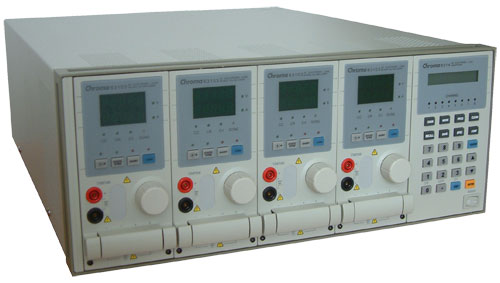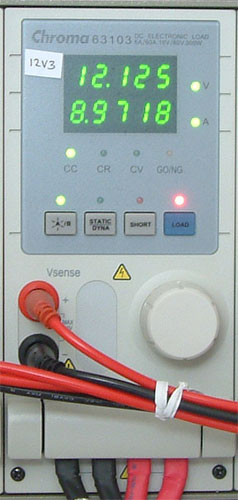AnandTech Power Supply Test Methodology
by Christoph Katzer on July 12, 2007 12:00 AM EST- Posted in
- Cases/Cooling/PSUs
Chroma Programmable DC Loads 6314

Our test equipment contains two Chroma programmable DC Loads which enable us to test power supplies with an output of up to 1500W. The biggest advantage of the Chroma DC Loads is simply the high precision it provides. It can measure differences as small as 0.001V and 0.0001Amp which will provide us with best-in-class results.
The Chroma programmable load is the heart of our equipment and controls the functions of the power supply. With it we can see the delivered voltage in response to the specific amount of load we are placing on each rail. In addition we will test security features like Over Current Protection (OCP), short circuit, and Over Power Protection (OPP).
A very important aspect in testing a power supply correctly is to put the right load on each rail. Stating that a 10% load is put on the power supply says nothing about the distribution of the load on each rail. For example, this 10% could be 80% load on the +12V1, 5% on +12V2 and +12V3, and 3% on +12V4; the rest would be on the other rails. In other words, simply giving a single all-encompassing load rating means that the load can be put on each rail differently, as long as the total load is always 10%. This is not a correct test according to the Intel Design Guide.

The guide clearly states how the percentages of loads need to be distributed on each rail, and we are working strictly according to this specification. It is not unusual to get an odd looking number since our calculations are strictly mathematical. One of these numbers can be seen in the above picture which shows a single load for the +12V3 rail. We are loading it at that moment with 8.9718 Amps which is the most accurate testing available in the market today. To make the data more accessible for our readers we will be rounding each result to the nearest hundredth, but that is still more accurate than what we see elsewhere.

Our test equipment contains two Chroma programmable DC Loads which enable us to test power supplies with an output of up to 1500W. The biggest advantage of the Chroma DC Loads is simply the high precision it provides. It can measure differences as small as 0.001V and 0.0001Amp which will provide us with best-in-class results.
The Chroma programmable load is the heart of our equipment and controls the functions of the power supply. With it we can see the delivered voltage in response to the specific amount of load we are placing on each rail. In addition we will test security features like Over Current Protection (OCP), short circuit, and Over Power Protection (OPP).
A very important aspect in testing a power supply correctly is to put the right load on each rail. Stating that a 10% load is put on the power supply says nothing about the distribution of the load on each rail. For example, this 10% could be 80% load on the +12V1, 5% on +12V2 and +12V3, and 3% on +12V4; the rest would be on the other rails. In other words, simply giving a single all-encompassing load rating means that the load can be put on each rail differently, as long as the total load is always 10%. This is not a correct test according to the Intel Design Guide.

The guide clearly states how the percentages of loads need to be distributed on each rail, and we are working strictly according to this specification. It is not unusual to get an odd looking number since our calculations are strictly mathematical. One of these numbers can be seen in the above picture which shows a single load for the +12V3 rail. We are loading it at that moment with 8.9718 Amps which is the most accurate testing available in the market today. To make the data more accessible for our readers we will be rounding each result to the nearest hundredth, but that is still more accurate than what we see elsewhere.










49 Comments
View All Comments
crimson117 - Thursday, July 12, 2007 - link
Good point. Just because a certain digital camera fails when it is submerged underwater, it doesn't mean all users should stick to only buying waterproof cameras. You'd still have a great camera, provided you keep it out of the water.
crimson117 - Thursday, July 12, 2007 - link
<quote>The ambient temperature around the power supply will constantly grow with the time of the test. It will be placed in the same set of conditions it will experience in a real system, where the temperature rises over time.</quote>I'm very glad to see this highlighted in your review strategy.
It always irks me when I see temperature scores of heatsinks which don't consider the variable temperature of the cooling substance (the air) that was used!
If you blow hot 90 degree air over something, the best it can do is cool that something to 90 degrees. If you blast a heatsink with cool compressed air, you'd get much lower heatsink temperatures.
Rocket321 - Thursday, July 12, 2007 - link
About that 5 layer box...I re-read that page a couple times but don't get it. How do you connect the PS unit to the programmable load without running a cable through the wall of the box? If I'm reading it right, you are using the internal PCB to reduce the # of cables you run through the wall to a single cable...?
I'm just curious as it wasn't immediatly clear what was going on there.
Otherwise I applaud you for the new branch of quality reviews you're starting. I look forward to the first review!
nrb - Thursday, July 12, 2007 - link
I'm slightly concerned by this statement: I would urge you not to start doing PSU reviews until you have got the measurement of ripple figured out. It's one of the most important measures of PSU performance, IMNSHO.kaborka - Saturday, July 14, 2007 - link
I second that. Measuring ripple on my scope under various loads is the first thing I do when I get a new PSU. I have an old surplus Tektronix I use. I would not be interested in any reviews that don't include ripple measurements -- it would be useless.But Thank You, THANK YOU for finally doing serious PSU tests. The sites that do fluff pieces about the latest shiny boxes have always irritated me no end!
EODetroit - Thursday, July 12, 2007 - link
HardOCP pretty much is the gold standard on real, tough, power supply reviews atm. It will be interesting to see if you get the same results as they do.One thing that happens all the time in the HardOCP reviews is that a PSU will work great up to about 75% of its rating, then fail or get out of spec. My question is... will you consider that a failure or will you just recommend the PSU as long as you don't go over 75% ? No one runs a PSU fully loaded on purpose anyways.
One more thing slightly off topic... how come Anand (and everyone else in the biz) is willing to load a PSU to the max but won't review a motherboard loaded with the maximum "supported" memory? The latter is a much bigger problem imo, and with 64 bit OSes now commonplace that can make use of all the memory in a computer, the time is right to start reviewing MBs that supposedly support 8 GB of ram... while actually loaded with 8 GB of ram.
CrystalBay - Thursday, July 12, 2007 - link
So how is PCP&C's 750 Silencer gonna stack up with it's 80mm fan???End The Power Supply Myths AT........
strikeback03 - Thursday, July 12, 2007 - link
I recently bought some motherboards to build desktop systems for some of our grad students. They claim support for 16GB RAM, but since they only have 2 slots for RAM testing 16GB falls somewhere between "extremely expensive" and "impossible".Martimus - Thursday, July 12, 2007 - link
I would like to see that as well. MB's performance with a full load of RAM. (Actually I would want to know if there are any other issues when you run it like that.)strikeback03 - Thursday, July 12, 2007 - link
Nice new toys:)On the Temperature page where it says "We will start at a room temperature of 77°F (25°C)" perhaps mention should be made that the "room" is actually a sealed box, which appears to have far less air volume (and circulation) than the average room, so the air will get far warmer than it ever should in an actual case.